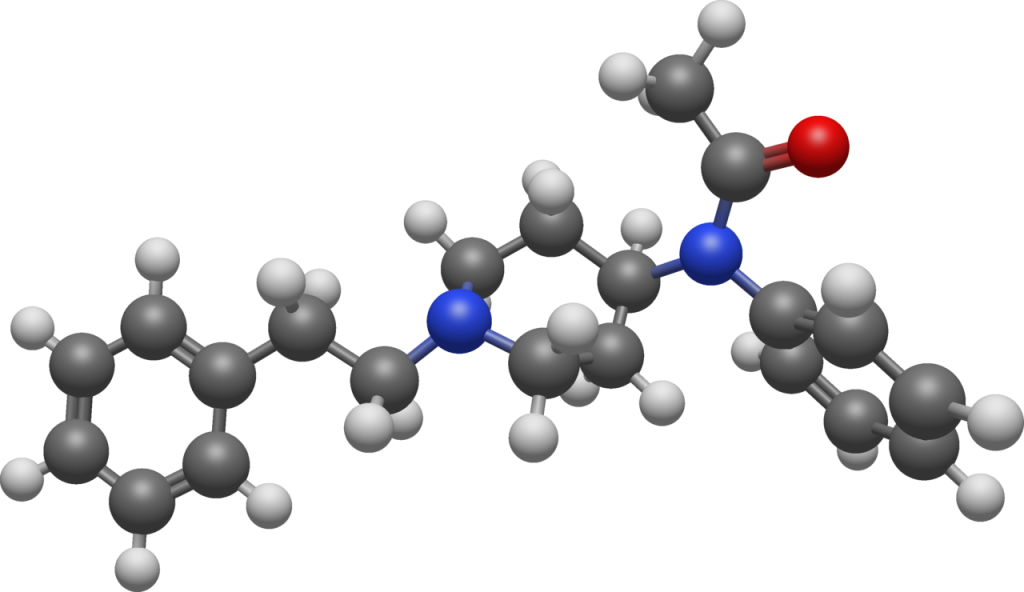Summary
Acetyl fentanyl, often referred to as acetyl fentanyl, is an opioid analgesic substance and a derivative of fentanyl, a powerful synthetic opioid. Research indicates that acetyl fentanyl is approximately fifteen times more potent than morphine. This potency suggests that, although slightly less powerful than fentanyl, it remains significantly stronger than pure heroin. It has never received approval for medical use and has instead been distributed exclusively as a designer drug.
The discovery of acetyl fentanyl dates back to the same period when fentanyl was first identified. However, during the late 1980s, it was rarely encountered on the illicit market. A notable shift occurred in 2013 when Canadian law enforcement seized three kilograms of acetylfentanyl.
As a μ-opioid receptor agonist, acetyl fentanyl can act as a direct substitute for heroin or other opioids. Its side effects are akin to those of fentanyl, encompassing symptoms such as itching, nausea, and potentially severe respiratory depression, which can pose life-threatening risks. Fentanyl analogs, including acetyl fentanyl, have been responsible for numerous fatalities across Europe and former Soviet republics during a resurgence in their use that was initiated in Estonia in the early 2000s. Additionally, new derivatives of these substances continue to emerge.
| Identifiers | |
|---|---|
| IUPAC name | |
| CAS Number | 3258-84-2 |
|---|---|
| PubChem CID | 527015 |
| ChemSpider | 459388 |
| UNII | 6DZ28538KS |
| CompTox Dashboard (EPA) | DTXSID80186275 |
| ECHA InfoCard | 100.169.973 |
| Chemical and physical data | |
| Formula | C21H26N2O |
| Molar mass | 322.452 g·mol−1 |


Deaths
- Europe Acetylfentanyl has been conclusively identified in 32 fatalities across four European member states spanning from 2013 to August 2015. These member states include Germany (2 cases), Poland (1 case), Sweden (27 cases), and the United Kingdom (2 cases).
- Russia Russia has reported twelve deaths linked to acetyl fentanyl since 2012.
- United States In the United States, the Centers for Disease Control and Prevention (CDC) issued a health alert after detecting 14 overdose deaths related to intravenous acetylfentanyl use between March 2013 and May 2013. These cases primarily involved intravenous drug users, ranging in age from 19 to 57 years, in Rhode Island. Pennsylvania, in response to confirming five overdoses, including one fatality in a single county, urged coroners and medical examiners across the state to screen for acetyl fentanyl. As a result of this investigation, Pennsylvania identified at least one acetyl fentanyl overdose death. It attributed a minimum of 50 fatalities to either fentanyl or acetyl fentanyl during the first half of 2013. Furthermore, the Drug Enforcement Administration (DEA) reported approximately 52 confirmed fatalities linked to acetyl fentanyl in the United States between 2013 and 2015, as of July 2015.
- Japan In 2016, a fatal poisoning case emerged due to the intravenous injection of a “bath salt” product containing acetyl fentanyl alongside 4′-Methoxy-α-pyrrolidinopentiophenone (also known as 4-MeO-α-PVP, a substituted cathinone).
Legal status
Canada Acetylfentanyl, being an analog of fentanyl, is classified as a Schedule I controlled substance in Canada.
China Since October 2015, acetyl fentanyl has been designated as a controlled substance in China.
United States In the United States, acetyl fentanyl was categorized as a Schedule I controlled substance in May 2015.
Switzerland has regulated acetyl fentanyl as a controlled substance as of March 2023.
United Kingdom Classified as an analog of fentanyl, acetyl fentanyl was classified as a class A drug in the United Kingdom back in 1986.
Overdose
Clinical Resemblance to Heroin Overdose Overdosing on acetyl fentanyl has been reported to exhibit clinical similarities to heroin overdosage. Furthermore, while naloxone (Narcan) can effectively treat acetyl fentanyl overdose, larger-than-normal doses of this antidote may be necessary.
Detection in Biological Samples Acetylfentanyl can be measured in blood, plasma, or urine using liquid chromatography-mass spectrometry. This method is employed to confirm poisonings in hospitalized individuals or provide evidence in forensic death investigations. In cases of acute overdosage, postmortem peripheral blood samples have shown acetyl fentanyl concentrations ranging from 89 to 945 μg/L.
FAQ
- What is Acetylfentanyl?
- Acetyl fentanyl is an opioid analgesic drug that belongs to the fentanyl analog family. It is chemically related to fentanyl, a potent synthetic opioid.
- How Potent is Acetylfentanyl?
- Acetyl fentanyl is estimated to be approximately fifteen times more potent than morphine. This makes it considerably stronger than pure heroin, although somewhat weaker than fentanyl itself.
- Has Acetylfentanyl Been Used for Medical Purposes?
- No, acetyl fentanyl has never been approved for medical use. It is exclusively found in illicit markets and is considered a designer drug.
- What Are the Side Effects of Acetylfentanyl?
- Similar to fentanyl, common side effects of acetyl fentanyl include itching, nausea, and potentially severe respiratory depression, which can be life-threatening.
- Has Acetylfentanyl Led to Fatalities?
- Yes, acetyl fentanyl has been associated with numerous fatalities worldwide. It has been implicated in overdose deaths in various countries, including the United States, Russia, and European nations.
- Do Drug Laws control Acetylfentanyl?
- Yes, acetyl fentanyl is classified as a controlled substance in many countries, including the United States, Canada, China, and Switzerland. It is subject to strict legal regulations due to its potential for abuse and harm.
- How is Acetylfentanyl Detected in the Body?
- Acetyl fentanyl can be quantitated in blood, plasma, or urine using liquid chromatography-mass spectrometry. This method is employed in medical settings to confirm poisonings and in forensic investigations to gather evidence.
- Is Naloxone Effective in Treating Acetylfentanyl Overdose?
- Yes, naloxone (Narcan) can reverse the effects of acetyl fentanyl overdose. However, larger-than-normal doses of naloxone may be required due to acetylfentanyl’s potency.
- Are there any Analogues or Related Substances to Acetylfentanyl?
- Yes, there are other fentanyl analogs and synthetic opioids, such as furanyl-fentanyl and carfentanil, which share similarities with acetylfentanyl and pose similar risks.
- When Did Acetylfentanyl First Appear on Illicit Markets?
- Acetyl fentanyl was rarely encountered on illicit markets until around 2013 when reports of its presence and associated overdoses began to emerge.
References
- “Controlled Drugs and Substances Act”. IsomerDesign.
- “Two Charged With Witness Tampering in Joint Woonsocket Police, DEA Investigation”. The United States Attorney’s Office: District of Rhode Island. US Department of Justice. 6 June 2013.
- European Monitoring Centre for Drugs Drug Addiction; European Police Office (June 2016). EMCDDA–Europol Joint Report on acetylfentanyl. European Monitoring Centre for Drugs and Drug Addiction (EMCDDA). doi:10.2810/890694. ISBN 9789291689163.
- Helander A, Bäckberg M, Beck O (20 April 2016). “Intoxications involving the fentanyl analogs acetylfentanyl, 4-methoxybutyrfentanyl and furanylfentanyl: results from the Swedish STRIDA project”. Clinical Toxicology. 54 (4): 324–32. doi:10.3109/15563650.2016.1139715. PMID 26850293. S2CID 41668288.
- Higashikawa Y, Suzuki S (June 2008). “Studies on 1-(2-phenethyl)-4-(N-propionylanilino)piperidine (fentanyl) and its related compounds. VI. Structure-analgesic activity relationship for fentanyl, methyl-substituted fentanyls and other analogues”. Forensic Toxicology. 26 (1): 1–5. doi:10.1007/s11419-007-0039-1. ISSN 1860-8965. S2CID 22092512.
- Aceto MD, Bowman ER, Harris LS, May EL (1989). “Dependence studies on new compounds in the rhesus monkey, rat, and mouse (1989)” (PDF). NIDA Research Monograph. 95: 578–631. PMID 2641054. Archived from the original (PDF) on 2016-12-22. Retrieved 2016-08-26.
- “Extremely potent painkiller hits Montreal black market”. CBS News. 13 May 2013.
- Mounteney J, Giraudon I, Denissov G, Griffiths P (July 2015). “Fentanyls: Are we missing the signs? Highly potent and on the rise in Europe”. The International Journal on Drug Policy. 26 (7): 626–31. doi:10.1016/j.drugpo.2015.04.003. PMID 25976511.
- Ruangyuttikarn W, Law MY, Rollins DE, Moody DE (May–June 1990). “Detection of fentanyl and its analogs by enzyme-linked immunosorbent assay”. Journal of Analytical Toxicology. 14 (3): 160–4. doi:10.1093/jat/14.3.160. PMID 2374405.
- Kroll D (29 August 2013). “CDC Issues Alert On Deadly New Designer Drug, Acetyl Fentanyl”. Forbes.
- Melent’ev AB, Kataev SS, Dvorskaya ON (February 2015). “Identification and analytical properties of acetyl fentanyl metabolites”. Journal of Analytical Chemistry. 70 (2): 240–248. doi:10.1134/S1061934815020124. ISSN 1061-9348. S2CID 95218072.
- Centers for Disease Control Prevention (CDC) (August 2013). “Acetyl fentanyl overdose fatalities–Rhode Island, March-May 2013”. MMWR. Morbidity and Mortality Weekly Report. 62 (34): 703–4. PMC 4604997. PMID 23985500.
- Lozier MJ, Boyd M, Stanley C, Ogilvie L, King E, Martin C, Lewis L (June 2015). “Acetyl Fentanyl, a Novel Fentanyl Analog, Causes 14 Overdose Deaths in Rhode Island, March-May 2013”. Journal of Medical Toxicology. 11 (2): 208–17. doi:10.1007/s13181-015-0477-9. PMC 4469714. PMID 25934111.
- Drug Enforcement Administration (July 2015). “Acetyl fentanyl” (PDF). Drug Enforcement Administration Office of Diversion Control.
- Yonemitsu K, Sasao A, Mishima S, Ohtsu Y, Nishitani Y (October 2016). “A fatal poisoning case by intravenous injection of “bath salts” containing acetyl fentanyl and 4-methoxy PV8″. Forensic Science International. 267: e6–e9. doi:10.1016/j.forsciint.2016.08.025. PMID 27591912.
- 关于印发《非药用类麻醉药品和精神药品列管办法》的通知 [Notice on Printing and Distributing the “Measures for the Scheduling of Non-Pharmaceutical Narcotic Drugs and Psychotropic Substances”]. sfda.gov.cn (in Chinese). 29 September 2015. Archived from the original on 1 October 2015. Retrieved 1 October 2015.
- “80 FR 29227 – Schedules of Controlled Substances: Temporary Placement of Acetyl Fentanyl into Schedule I”. U.S. Government Publishing Office (GPO). 21 May 2015.